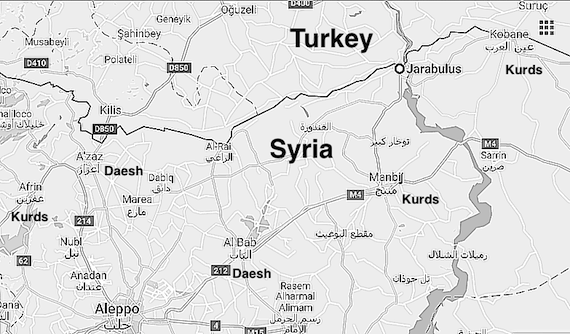Syria and drawing the web of tensions
[ by Charles Cameron — with a Magnus Ranstorp squib in its tail ]
.
The issue is complexity, and how you represent it. The case in point is Syria.
Here’s a diagram that suggests complexity as a sort of crazy weaving, all straight lines and colors:
This *simple* chart shows all states of hostility currently being played out on #Syria’s territory#IntractableWar pic.twitter.com/1inprNB6U0
— Charles Lister (@Charles_Lister) February 13, 2016
Daveed’s diagram has a network feel to it, with actord as nodes and the tensions between them as edges:
A pretty good graphic on the Syrian conflict (though quibblers gonna quibble). It illustrates ISIS's weak strategy: https://t.co/j1ccZpvGjT
— Gartenstein-Ross (@DaveedGR) August 26, 2016
Karl Sharro’s tackling the wider context, but his illustration at least gives the sense of a ball of twine after a cat has carefully re-arranged it:
Following recent event, updated diagram of geopolitical relationships in the Middle East pic.twitter.com/3QmDxZtnSn
— Karl Sharro (@KarlreMarks) March 26, 2015
Juan Cole simply provides a screenshot from Google Maps —
— the headline America’s Syria SNAFU: Pentagon’s Militias fight Turkey & CIA’s Militias — which is effectively friendly fire framed as paradox — and some paras beneath it using words to describe the tangle:
The Turkish incursion into Syria at Jarabulus was advertised as an attack on a Daesh (ISIS, ISIL) stronghold and smuggling station in conjunction with (fundamentalist) remnants of the Free Syrian Army.
But the southern outskirts of Jarabulus had already fallen to the Pentagon-backed Syrian Democratic Forces, which are majority Kurdish but have a significant Arab component. The Arab, non-Kurdish SDF brigades such as the Seljuk brigade, the Army of Revolutionaries, and Northern Sun Brigade had fought to liberate the northern Syrian city of Manbij, due south of Jarabulus from Daesh. They have an outpost in the village of Amarna just a few miles south of Jarabulus, where they call themselves the Jarabulus Military Council.
The Turkish army, having secured Jarabulus itself with the help of fundamentalist militias, moved down to Amarna, where they met fierce resistance from the Syrian Democratic Forces, who are allied with the Kurds. The Turkish air force bombarded the SDF positions in Amarna and the militias responded by destroying two tanks and killing one Turkish soldier. Fighting continues there.
To be honest, I’m not sure which of those means of modeling a complex system leaves us best able to understand the situation on the ground.
**
Maybe this one’s the best:
Sir Mark Allen once told me to fully understand Syrian conflict is like playing 3D chess under water with all pieces moving simultaneously.
— Magnus Ranstorp (@MagnusRanstorp) September 9, 2016




September 9th, 2016 at 7:18 pm
I just posted this as a comment to today’s Ouroboros item, but it belongs here too. It contains a self-reference in an RFERL “Under The Black Flag” analysis of Syria: